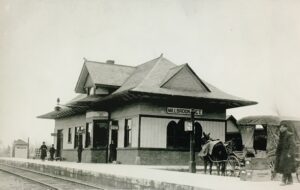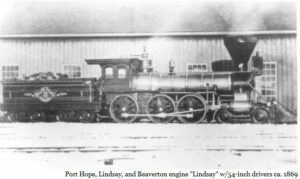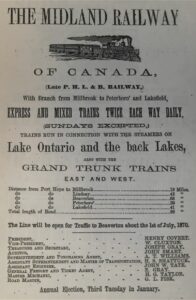Articles

Millbrook Junction Station - early 1900's


Advertisement for the Midland Railway - 1870
When the Railway Comes to Town
From the mid 1800s to mid 1900s travel by rail was by far the best means of land transport for both passengers and freight. What roads that existed were primitive; most modern logging roads would look like a freeway by comparison. Shipping heavy goods such as lumber was practical only by water. In the early 1800s canals such as the Welland, Lachine and Rideau canal system were built to open up the major waterways of the Great Lakes, Ottawa and St. Lawrence River, but travel in the vast interior of Upper Canada remained difficult.
However, by the 1840s a revolution in transportation was underway. Steam powered engines (locomotives) had been developed to pull cars loaded with goods or people along iron rails or tracks. “Railway Mania” swept across the colony as groups of investors (and land speculators) formed to fund the construction of railways across the countryside.
So, what does this have to do with this particular corner of Upper Canada? An attempt in the 1840s was made to fund a railway from Port Hope to the growing town of Peterborough but this fell through. Another proposal was made in 1852 but by this point the Peterborough investors had decided to join a group in Cobourg to build a railway. This line went across Rice Lake on a very long trestle bridge and causeway system which ultimately failed due to damage from winter ice and was abandoned. Remnants of the trestle posts remain a hazard to motorboat propellers when water is low on Rice Lake to this day.
The Port Hope group then decided to build the line to Lindsay and continue on to Beaverton and the Port Hope, Lindsay and Beaverton Railway was formed. In June 1853 shanties were built on the outskirts of Port Hope to house the workers. Wages were 89 cents/day, the workday 6 am to 6 pm, six days a week. The line wound its way north up the Ganaraska River valley through Campbellcroft before heading northwest across the Middle Road (County Road 10) up to Millbrook.
All the work was done by hand with axe, pick and shovel, with the help of horse and ox drawn wagons. The terrain was difficult, often hilly and heavily wooded, which made progress slow. A wooden trestle bridge several hundred yards long was constructed across the Baxter Creek valley south of the 4th Line, a remarkable feat of engineering. Unfortunately the bridge burned in 1866 and was replaced by an earthen berm with an impressive arched stone culvert through which Baxter Creek flows. It can be visited today by taking a walk along the Millbrook Valley Trails near the Trout Ponds off Zion (4th) Line. Elsewhere, other parts of the trail network run along the old railbed.
Even before the line was completed there was an impact on the local economy. In 1943, Fred Charry of Millbrook reminisced “Mother remembers… the construction caused considerable activity in the district and unemployment was unknown. Farmers sold much of their commodities to the construction crew so that an era of prosperity, theretofore rare, was enjoyed. The store keepers and taverns of Millbrook and nearby hamlets also came in for a share of the business.”
The line to Millbrook was completed in November, 1856. Various Port Hope business leaders, politicians and hangers on boarded the inaugural train to Millbrook, expecting a grand welcome at the other end. Unfortunately, nobody had notified the folks in Millbrook to expect them and there was no welcoming party. The VIPs were not impressed and this “snub” made headlines in the Port Hope newspaper. Oh to have scandals like this today.
By 1857 the line had been completed to Lindsay and extended to Beaverton in 1869. The Peterborough investors agreed to fund a branch line from Millbrook and this opened to traffic in May 1858.
To celebrate the opening of the line to Peterborough a free ride was offered to all who wished to travel on this wondrous marvel. There weren’t enough passenger cars available so open flat cars with chairs placed on them were pressed into service. The passenger cars were reserved for women; the gents were out in the open “behind a dusty, smelly wood burning locomotive”. An estimated 2,000 people from Port Hope and Millbrook went along for the trip at a thrilling 20 miles per hour. Fred Clarry wrote that as a child his mother Harriet had gone along for the ride and recalled that a schoolhouse near the Peterborough branch line closed to watch the great occasion. “The cheering was not vociferous because the children were nervous and timid as the train approached. Awed and frightened they clutched fences and peeped from behind bushes when the fiery monster with its human freight “flew” past. The event was the talk of the village for days”.
On the way home the locomotive (named Hope) ran low on fuel and steam pressure sufficient to pull the weight of the cars and their occupants could not be maintained. The cars had to be unhitched “in the middle of nowhere” while the locomotive limped back to Millbrook to refill its tender with wood. Apparently the trip was a resounding success despite this mishap.
To be continued.
To find out more: the Millbrook & Historical Society has a number of publications available.

